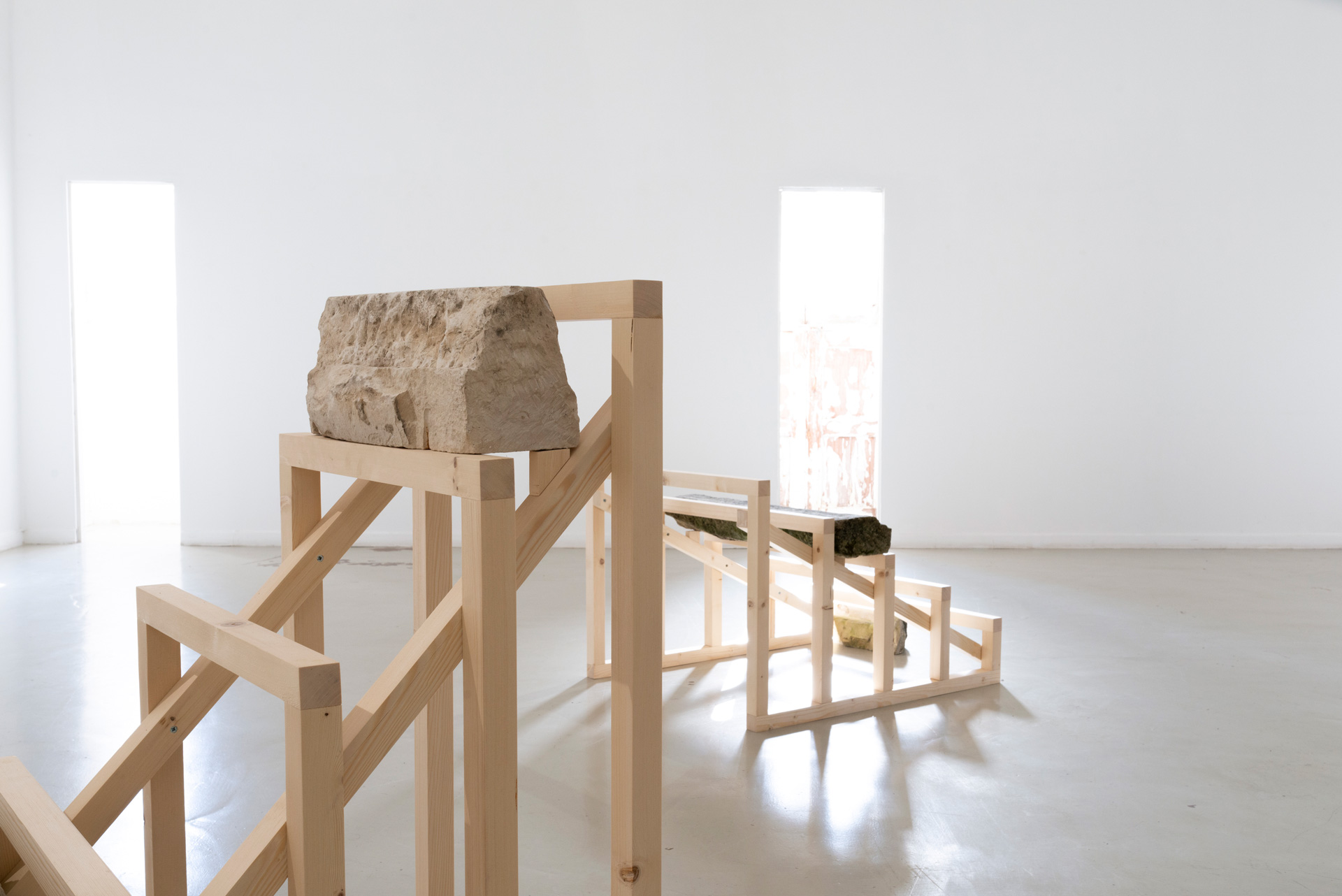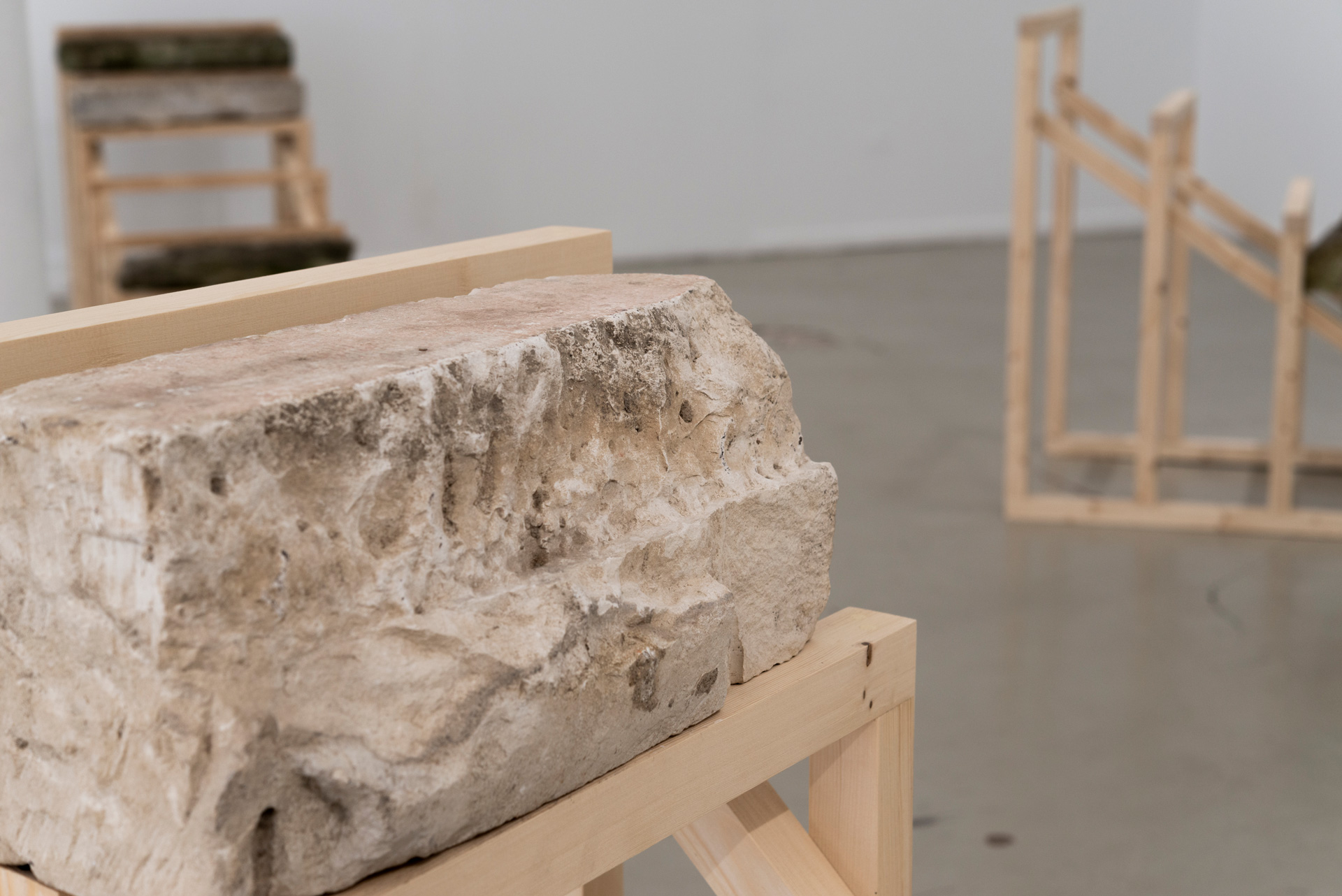
Teach us to sit still
solo show at
Colégio das Artes
Universidade de Coimbramay 2022
Teach us to sit still is an appeal. It is also an exhibition in motion.
Developed in a site-specific context with works by Marcelo Moscheta and curated by Master's students in Curatorial Studies, it begins and ends — like an old ladder that sometimes goes up and sometimes down — what will be the path live from SEMINAR/ Seminarium_Curated Research: The Academy as medium.
Starting from an exercise in the resignification of objects as materialized memories, Moscheta raises a set of stones rescued from the cloister of the Colégio das Artes that — suspended in their light and transferred permanence — now rest on a series of devices designed by the artist, evoking the transmutable essence of the sensitive archeology of a temporal ruin.
Concomitantly with the natural and intuitive gesture of the building present in Desterro, and simultaneously with its physical condition in the axes of the gallery, a smaller-scale work is also presented — Terrain vague — where a small diagonal cut determines a spatial rupture that, despite the its innate quality as a unique and familiar landscape, summons a new portal to ethereal places and suspended gravities.
This is an exhibition in motion, but it is also a calling to delay — even among these rocks.
curators:
Adolfo Caboclo
Eva Mendes
Joana Oliveira
Malu Patury
Patricia Lima
Starting from an exercise in the resignification of objects as materialized memories, Moscheta raises a set of stones rescued from the cloister of the Colégio das Artes that — suspended in their light and transferred permanence — now rest on a series of devices designed by the artist, evoking the transmutable essence of the sensitive archeology of a temporal ruin.
Concomitantly with the natural and intuitive gesture of the building present in Desterro, and simultaneously with its physical condition in the axes of the gallery, a smaller-scale work is also presented — Terrain vague — where a small diagonal cut determines a spatial rupture that, despite the its innate quality as a unique and familiar landscape, summons a new portal to ethereal places and suspended gravities.
This is an exhibition in motion, but it is also a calling to delay — even among these rocks.
curators:
Adolfo Caboclo
Eva Mendes
Joana Oliveira
Malu Patury
Patricia Lima
Notes on Teach us to sit still
1.What comes into appearance must segregate in order to appear1
In the beginning there was a path.
Even though it was not drawn on a map, that path was in the genes of Being, long before that Being existed and the very trees and stones that accompany it appeared. That path followed points, directions guided by the sun and the projected shadows of the mountains on the plains, bouncing at its feet. As long as a state of anxiety or dissatisfaction existed, the path did not cease, nor was the Being able to rest. Only when it was aware of emptiness was it offered a moment of contemplation. Consenting to emptiness meant for the Being to endure its nomadic condition, to deceive its nature and for a moment to look at a star instead of following it. However, whenever it found this place, the Being was stuck in the solidity of its permanence again, and thus it started walking again.
2. Turn the old; return to them. Things do not change; we change 2
If we look at walking as the first aesthetic act, we simultaneously look at our body as the first material of landscape, of sculpture, as a decisive action within a space: a body made object, a ritual made narrative. If the distance that exists between Man and the Earth is as circumstantial as this awareness, then just as the Egyptians attributed to each human body the presence of ka - or the spirit of eternal wandering - so too can we attribute it to each stone. Man is, like the mountain before him, the very landscape that reflects the mountain. He is a place off the map as much as a stone off the ground.
3. About time in the fold
Or how the (re)position of something
Discovers through the middle
Another form
Of apprehension and experience
The artist begins the recognition of his field of work, he studies the forms that permeate it and the possible times in that place - an immaterialised past, a concrete present and a future yet to be revealed. In doing so, he powers an exercise in recognition that attunes him to his surroundings - at that precise moment - without ever being able to see beyond that instant. By trusting the empirical knowledge he now possesses, the artist negotiates with his innate gestures, curious vices stronger than himself, and participates in the third temporal moment discussed above - a moment of revelation. Concrete matter is metamorphosed, translated into coordinates and reconstituted on another ground. Perhaps there is now an invisible link between these two states, a diagonal possible to intersect in the ephemerality of this Beckettian square time. The artist then walks towards that secret, from which he perversely hides himself as well. He has, at the same time, the enormous generosity not to reveal it.
[text by Eva Mendes]
1 Robert Morris after Goethe in Notes on Sculpture, Artforum, 1966
2 Thoreau, Walden, Penguin Books, 2014
3 Faria, Daniel, Poemas, Assírio e Alvim, 2020






















Teach us to sit still
exposição individual no Colégio das Artes
Universidade de Coimbramaio 2022
Teach us to sit still é um apelo. É também uma exposição em movimento.Desenvolvida em contexto site-specific com obras de Marcelo Moscheta e com curadoria dos alunos de Mestrado em Estudos Curatoriais, ela inicia e encerra — como uma velha escada que ora sobe, ora desce — aquele que será o caminho vivo do SEMINÁRIO/ Seminarium_Curated Research: The Academy as medium.
Partindo de um exercício de ressignificação de objetos enquanto memórias materializadas, Moscheta eleva um conjunto de pedras resgatadas do claustro do Colégio das Artes que — suspensas na sua leve e transladada permanência — repousam agora sobre uma série de dispositivos desenhados pelo artista, evocando a essência transmutável da arqueologia sensível de uma ruína temporal.
Concomitantemente ao gesto natural e intuitivo da edificação presente em Desterro, e simultânea à sua condição física nos eixos da galeria, é também apresentada uma obra de menor escala — Terrain vague — onde um pequeno corte em diagonal determina uma rutura espacial que, não obstante à sua qualidade inata de paisagem única e familiar, convoca um novo portal para lugares etéreos e gravidades em suspensão. Esta é uma exposição em movimento, mas é também uma convocação da demora — even among these rocks.
curadores:
Adolfo Caboclo
Eva Mendes
Joana Oliveira
Malu Patury
Patricia Lima
Partindo de um exercício de ressignificação de objetos enquanto memórias materializadas, Moscheta eleva um conjunto de pedras resgatadas do claustro do Colégio das Artes que — suspensas na sua leve e transladada permanência — repousam agora sobre uma série de dispositivos desenhados pelo artista, evocando a essência transmutável da arqueologia sensível de uma ruína temporal.
Concomitantemente ao gesto natural e intuitivo da edificação presente em Desterro, e simultânea à sua condição física nos eixos da galeria, é também apresentada uma obra de menor escala — Terrain vague — onde um pequeno corte em diagonal determina uma rutura espacial que, não obstante à sua qualidade inata de paisagem única e familiar, convoca um novo portal para lugares etéreos e gravidades em suspensão. Esta é uma exposição em movimento, mas é também uma convocação da demora — even among these rocks.
curadores:
Adolfo Caboclo
Eva Mendes
Joana Oliveira
Malu Patury
Patricia Lima
Notas sobre Teach us to sit still
1.What comes into appearance must segregate in order to appear 1
No início havia um caminho.
Ainda que não estivesse desenhado num mapa, esse caminho estava nos genes do Ser, muito antes sequer desse Ser existir e das próprias árvores e pedras que o acompanham aparecerem. Esse caminho seguia pontos, direções orientadas pelo sol e pelas sombras projetadas das montanhas nas planícies, a rebaterem aos seus pés. Enquanto existisse um estado de ansiedade ou insatisfação, o caminho não cessava, nem tão-pouco o Ser era capaz de repousar. Somente aquando da consciência do vazio lhe era oferecido um momento de contemplação. Consentir o vazio, significava para o Ser suportar a sua condição de nómada, enganar a sua natureza e por momentos olhar para uma estrela ao invés de a seguir. Contudo, sempre que encontrava esse lugar, o Ser ficava encalhado na solidez da sua permanência outra vez - então tornava a caminhar.
2. Turn the old; return to them. Things do not change; we change 2
Se olharmos para o caminhar enquanto primeiro ato estético, olhamos simultaneamente para o nosso corpo enquanto primeira matéria da paisagem, da escultura, enquanto ação decisiva dentro de um espaço, - corpo tornado objeto, ritual tornado narrativa. Se a distância que existe entre o Homem e a Terra for tão circunstancial como esta consciência, então do mesmo modo que os egípcios atribuíam a cada corpo humano a presença do ka - ou espírito da eterna deambulação - também assim o podemos atribuir a cada pedra. O Homem é, à semelhança da montanha que o antecede, a própria paisagem que reflete a montanha. Ele é um sítio fora do mapa tanto quanto uma pedra fora do chão. 3
3. Sobre o tempo na dobra
Ou como a (re)posição de algo
Descobre pelo meio
Uma outra forma
De apreensão e experiência
O artista principia o reconhecimento do seu campo de trabalho, estuda as formas que o permeiam e os tempos possíveis naquele lugar - um passado imaterializado, um presente concreto e um futuro por revelar. Ao fazê-lo, potencia um exercício de reconhecimento que o sintoniza com o seu arredor - naquele preciso momento - sem nunca o poder ver para além daquele instante. Ao confiar no conhecimento empírico que agora possui, o artista negoceia com os seus gestos inatos, vícios curiosos mais fortes do que si, e participa no terceiro momento temporal abordado anteriormente - o momento de revelação. A matéria concreta é metamorfoseada, transladada em coordenadas e reconstituída sobre um outro chão. Talvez agora exista um elo invisível entre esses dois estados, uma diagonal possível de intersectar na efemeridade desse tempo quadrado Beckettiano. O artista caminha então para esse segredo, do qual perversamente se esconde também. Tem, ao mesmo tempo, a generosidade enorme de não o revelar.
[texto de Eva Mendes]
1 Robert Morris after Goethe in Notes on Sculpture, Artforum, 1966
2 Thoreau, Walden, Penguin Books, 2014
3 Faria, Daniel, Poemas, Assírio e Alvim, 2020